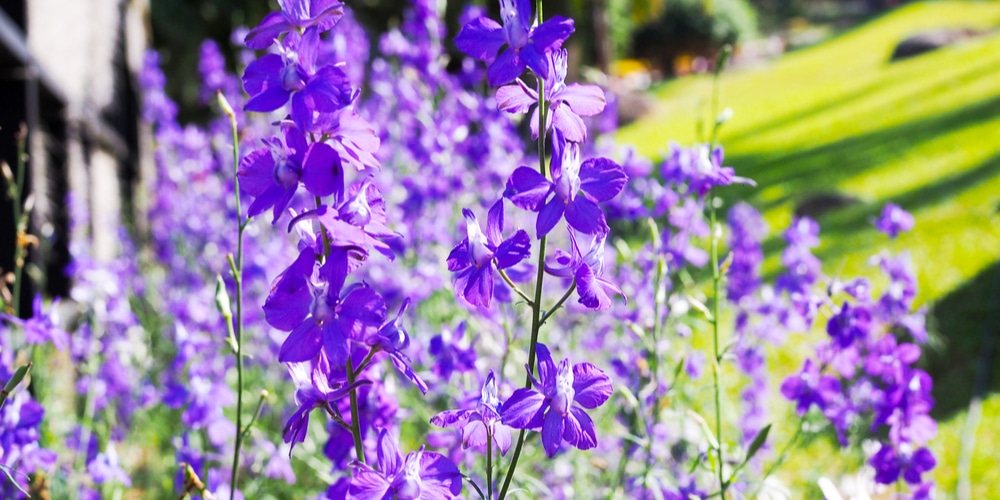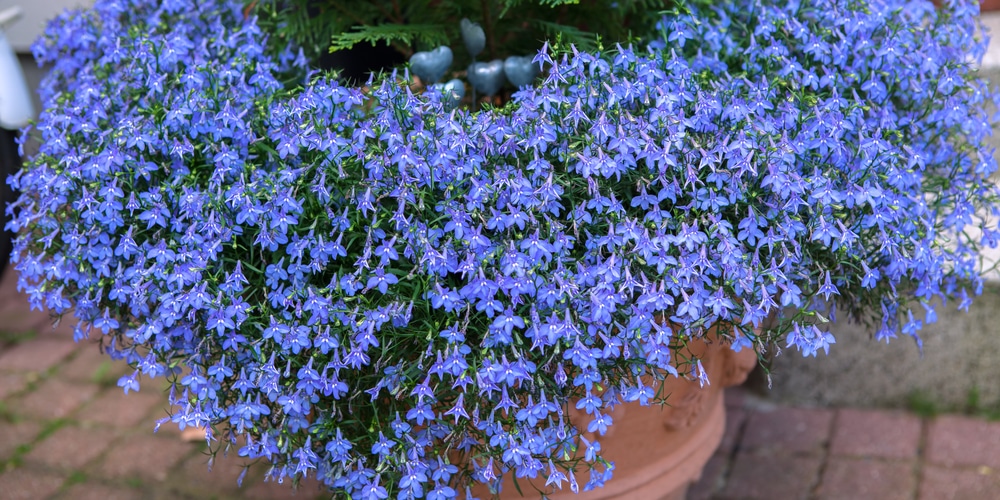The Great Blue Lobelia is part of the Bellflower (Campanulaceae) family, including more than 2,400 species. Most herbaceous species are native to Europe, North America, and Asia. There are some species from Africa, mainly South Africa. Of the 2,400 species, 43 are commonly found in the US and Canada. Let’s look at growing and caring for the Great Blue Lobelia plant!
| Scientific Name | Lobelia siphilitica |
| Plant Type | Perennial |
| Sun Requirements | Full Sun to Partial Shade |
| USDA Hardiness Zones | 4-9 |
| Soil PH Range | Alkaline, Neutral |
| Soil Type | Clay, Loam, Sand, Rich in Organic Matter |
| Water Needs | High |
They can grow up to 2 to 4 feet and spreads 12 to 18 inches. The plant’s stem is scarcely hairy or smooth, while the leaves are 3 to 3.47 inches long and 0.6 to 1.6 inches wide.
It produces a single upright stem with the flowers arranged in an elongated cluster – 4 to 12 inches long. Blue-violet or white, they are about 1 inch long. On the backside of the flowers, you can find short hairs.
As an architectural plant that adds vertical interest around your home, its nectar and pollen attract bumblebees. It also attracts hummingbirds, butterflies, and other bees. The plant is extremely hardy, low care, and pest free.
The Great Blue Lobelia is commonly found in damp to wet soil, often in areas with some shade. This plant is native to the following areas in the US – Colorado, Texas, Wyoming, Dakotas, Maine, and Georgia west. In Canada, it’s commonly found in Manitoba and Ontario.
According to historians, Native Americans used the Lobelia to treat respiratory disorders. The Blue Lobelia is potentially poisonous as it contains lobeline. This is an alkaloid with similar effects as nicotine on the nervous system.
How to Care for Great Blue Lobelia
Here’s everything you need to know about growing and caring for a thriving Great Blue Lobelia.
Light
The clump-forming Great Blue Lobelia thrives in full sun to partial shade. It appreciates some shade from the hot afternoon sun and loves moisture, especially in summer when dry spells are common.
You can grow the Great Blue Lobelia in a container, but you must give it ample sunlight. This means the plant should receive at least 6 hours of sunlight every day. The plant also performs equally well under part shade, mainly if it gets direct morning sun.
Water and Soil Needs
The Great Blue Lobelia works well in wildflower beds or rain gardens. This is true, especially where the long summer blooming season makes the plant a centerpiece on your landscape.
To ensure the Great Blue Lobelia grows and blooms, well-drained and rich organic soil work best. In moderate soil, you need at least a 2-inch layer of compost before you plant. This helps to improve drainage and increase the natural nutrients and organic matter in the site.
You can grow the Blue Lobelia from seed sown directly in a garden bed or from nursery transplants. To ensure the plants thrive and prevent crowding, space them about 12 inches apart.
The Great Blue Lobelia grows best in moist soil. So, regular watering will ensure your plants grow healthy and produce attractive flowers. You need to water your Blue Lobelia twice a week, especially during dry spells.
Simply, make sure the top 6 inches of the soil remains moist all the time. We do recommend covering the ground with a 2-inch layer of mulch. This will allow the soil to retain moisture and stay damp.
Since the Blue Lobelia grows as a wildflower, it does not require fertilizer. However, spreading an inch or two of compost each spring provides most nutrient needs.
Temperature Requirements
If growing the Great Blue Lobelia from seed, start at least five weeks before the outdoor night temperatures are in the 10 C or 50 F range. Since the plant is hardy, it can tolerate 5 to 14 F or -15 to -10 C.
The Great Blue Lobelia is suitable for growth in USDA hardiness zones 4 to 9 and requires full sun, but it performs well under part shade.
Fertilizer
Perennial Blue Lobelia does not require fertilizer. However, a layer of two inches of compost each spring will provide the much-needed nutrients. With annual lobelia, they require frequent feeding to bloom throughout the season.
We recommend that you use liquid fertilizer with a ratio of 12-4-8. Mix at a rate of 1 teaspoon per gallon of water every two to three weeks. Alternatively, you can mix in a slow-release fertilizer while planting then reapply every few months.
Common Diseases
The Great Blue Lobelia faces little or no threat from common garden insects and pests. As such, it’s safe from typical plant diseases and problems. However, snails and slugs can damage the foliage. This is because they love to feed on the leafy stalks.
While you can grow the Blue Lobelia in full sun, they don’t care for drought or heat. This is because their transport tissues aren’t designed to work under extreme heat. As such, you may notice the leaves turning brown and curling up.
If your Blue Lobelia has healthy stems but brown leaves, it means you failed to water the plants as required because you exposed them to too much sun.
Propagation
Here are the steps involved in properly propagating Great Blue Lobelia.
1. Using Seeds
You can propagate the Great Blue Lobelia using seeds. Start by growing the seedlings inside, then translocate them outdoors 8 to 10 weeks after germination. Space the seedlings between 18 to 24 inches (45 – 60cm) apart in your garden bed during planting. This helps to prevent crowding.
2. Using Cuttings
To propagate the Great Blue Lobelia using cutting, you need two node stem cuttings at least 4 to 6 inches (10 to 15 cm) long. Treat the cuttings with a rooting hormone, then place them in a mixture of perlite and sand.
Cover the cuttings lightly, give them plenty of light and keep the soil moist. The roots should sprout in 2 to 3 weeks if you do so. You can divide the clumps of growing plants in spring or fall. However, you must keep them moist and replant them immediately.

